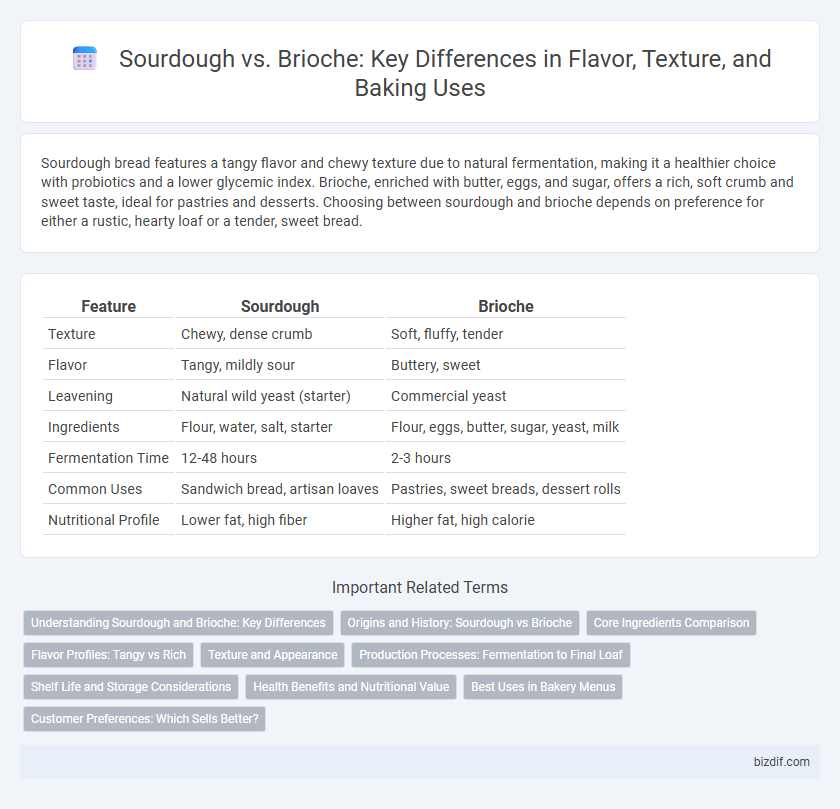Sourdough bread features a tangy flavor and chewy texture due to natural fermentation, making it a healthier choice with probiotics and a lower glycemic index. Brioche, enriched with butter, eggs, and sugar, offers a rich, soft crumb and sweet taste, ideal for pastries and desserts. Choosing between sourdough and brioche depends on preference for either a rustic, hearty loaf or a tender, sweet bread.
Table of Comparison
| Feature | Sourdough | Brioche |
|---|---|---|
| Texture | Chewy, dense crumb | Soft, fluffy, tender |
| Flavor | Tangy, mildly sour | Buttery, sweet |
| Leavening | Natural wild yeast (starter) | Commercial yeast |
| Ingredients | Flour, water, salt, starter | Flour, eggs, butter, sugar, yeast, milk |
| Fermentation Time | 12-48 hours | 2-3 hours |
| Common Uses | Sandwich bread, artisan loaves | Pastries, sweet breads, dessert rolls |
| Nutritional Profile | Lower fat, high fiber | Higher fat, high calorie |
Understanding Sourdough and Brioche: Key Differences
Sourdough bread is characterized by its naturally fermented dough, resulting in a tangy flavor, chewy texture, and a thick, crisp crust, often made with wild yeast and lactic acid bacteria. Brioche, by contrast, is a rich, buttery French bread with a soft, tender crumb and a slightly sweet taste, created with high amounts of eggs and butter in the dough. Key differences include fermentation method, ingredient ratios, and flavor profiles, where sourdough relies on natural fermentation and a lean dough, while brioche emphasizes enriched dough and a delicate, sweet richness.
Origins and History: Sourdough vs Brioche
Sourdough traces its origins to ancient civilizations, with evidence of natural fermentation dating back over 5,000 years in Egypt, making it one of the oldest forms of bread. Brioche, on the other hand, emerged in France during the Middle Ages, distinguished by its rich, buttery dough that reflects its aristocratic roots. The contrasting histories highlight sourdough's rustic, natural fermentation process and brioche's luxurious, enriched texture shaped by cultural influences.
Core Ingredients Comparison
Sourdough and brioche distinguish themselves primarily through their core ingredients; sourdough relies on a natural fermentation process with wild yeast and bacteria, flour, water, and salt, creating a tangy flavor and chewy texture. Brioche incorporates enriched ingredients such as butter, eggs, sugar, and milk, resulting in a rich, tender crumb and slightly sweet taste. These fundamental differences in ingredient composition directly influence the breads' texture, flavor, and baking properties.
Flavor Profiles: Tangy vs Rich
Sourdough bread features a distinctive tangy flavor profile derived from its natural fermentation process using wild yeast and lactic acid bacteria. Brioche offers a rich, buttery taste and tender crumb due to its higher content of eggs, butter, and sugar, resulting in a slightly sweet and decadent flavor. The contrast between sourdough's bright acidity and brioche's creamy sweetness highlights their unique sensory experiences in artisanal baking.
Texture and Appearance
Sourdough features a rustic, chewy texture with a thick, crisp crust and an open crumb characterized by irregular holes, while brioche boasts a soft, tender crumb with a rich, buttery flavor and a golden, glossy exterior due to an egg wash. The sourdough's rough surface contrasts sharply with brioche's smooth, pillowy appearance. These textural and visual differences influence their use in baking, with sourdough favored for hearty sandwiches and brioche preferred for delicate pastries and sweet treats.
Production Processes: Fermentation to Final Loaf
Sourdough production relies on natural wild yeast and lactobacilli fermentation, requiring an extended fermentation period of 12 to 48 hours to develop its distinctive tangy flavor and chewy texture. Brioche, enriched with high butter and egg content, undergoes a shorter fermentation, typically 1 to 3 hours, relying on commercial baker's yeast to produce a light, tender crumb with a rich, buttery taste. The sourdough process demands careful temperature and hydration control to maintain starter activity, while brioche dough requires delicate handling and proofing to achieve its characteristic airy, golden crust.
Shelf Life and Storage Considerations
Sourdough bread offers a longer shelf life due to its natural acidity, which inhibits mold growth, allowing it to stay fresh for up to 5-7 days when stored in a cool, dry place. Brioche, rich in butter and eggs, has a shorter shelf life of around 2-3 days and requires airtight storage to maintain its soft texture and prevent staleness. Proper refrigeration can extend both breads' freshness but may impact brioche's delicate crumb, whereas sourdough retains flavor and texture better at room temperature.
Health Benefits and Nutritional Value
Sourdough bread offers significant health benefits due to its natural fermentation process, which enhances digestibility and promotes gut-friendly probiotics. It has a lower glycemic index compared to brioche, making it a better option for blood sugar control. Brioche, rich in butter and eggs, provides higher calories and fat content, but also supplies essential nutrients like vitamin A and iron.
Best Uses in Bakery Menus
Sourdough's tangy flavor and chewy texture make it ideal for artisanal sandwiches, toast, and rustic bread baskets, enhancing savory bakery menu options. Brioche's rich, buttery crumb and soft, airy consistency suit sweet pastries, dessert breads, and gourmet burgers, adding indulgent appeal to baked goods. Both breads offer distinct culinary versatility, catering to diverse customer preferences in bakery menus.
Customer Preferences: Which Sells Better?
Sourdough bread appeals to customers seeking a tangy flavor and artisanal quality, often preferred by health-conscious buyers for its natural fermentation and digestibility. Brioche attracts those who enjoy a richer, buttery texture and slightly sweet taste, favored in dessert or breakfast markets. Sales tend to vary by region and target audience, with sourdough trending higher in urban markets focusing on organic and artisanal products, while brioche performs strongly in cafes and bakeries emphasizing indulgent pastries.
Sourdough vs Brioche Infographic

 bizdif.com
bizdif.com